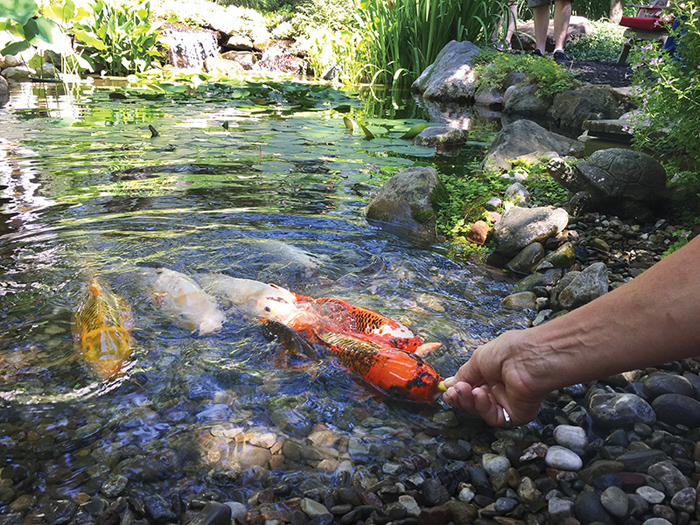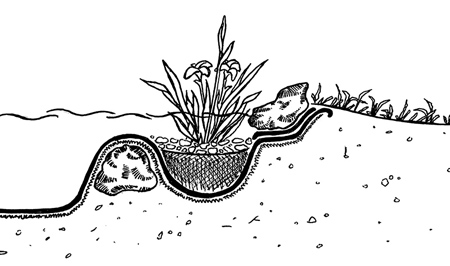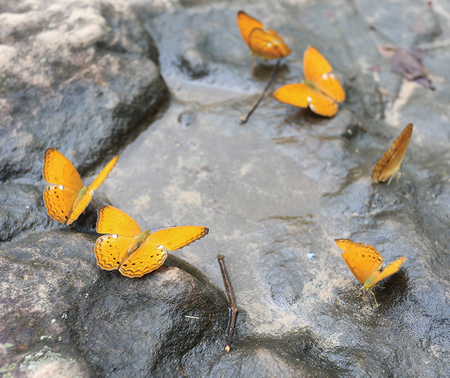
We water gardeners generally enjoy seeing nature and the ecosystems that surround us. Adding a water garden to a landscape is a great way to add more nature that is up-close and personal. While many enjoy the sound of water and others are drawn to the beauty of waterlilies and fish, there are other ways that water gardens can be enjoyed. Attracting wildlife to your water garden is one of those ways, and it’s sometimes overlooked due to fear of potential problems — many of which can be easily solved.
>> Related Article | Successful Winterization Techniques for Outdoor Ponds.
It goes without much debate that simply adding water to a landscape will attract some wildlife. A simple, dripping water bath is very attractive to a lot of birds. The focus of this article is how to enhance the design of a water garden to attract more varieties of critters. Although most people will not use all these design considerations, you may want to incorporate a few of them.
Natural Ponds
A wildlife or natural pond will change from one season to the next, depending on the age, design and variety of wildlife that the pond attracts. Expecting this type of pond to look a certain way may not happen, so remember to expect the unexpected. I read a few years ago that anything that enters a pond will affect it in some way, and I think this especially holds true with wildlife ponds. Some things will be more altering than others, of course. A bird, for example, can bring in fish eggs with its feet. This will not happen very often, of course, but it will on occasion.
Ponds for wildlife are generally not appropriate for high-value fish like high-end koi. Many types of wildlife will dine on fish, and brightly-colored fish are very susceptible to predation. The coloration of native fish makes them well camouflaged. They are generally dark-colored on top and silver-colored on the bottom. It is more difficult for a predator to see a fish with a green or dark dorsal aspect from above. The same holds true when a predator is looking at a fish with a light belly against a bright sky. We have circumvented evolution by selecting brightly-colored fish, thereby making our hand-selected fish more vulnerable to predation. The point is that fish selected for wildlife ponds need to be either low-valued, brightly-colored fish, or native fish that are naturally camouflaged. So, place those expensive fish in a pond that is designed for protecting these fish — not a wildlife pond.

One of my clients’ ponds actually became a wildlife pond by chance, not by choice. A belted kingfisher had begun preying on his small goldfish in a pond that was just outside his living room window. He was initially very upset that this bird was eating his comet goldfish, so he asked me to recommend a way to stop this predation. After witnessing this bird perching on a wire directly above the pond and then diving into the clear water, chasing and catching a goldfish underwater, I said, “Wow!” I had never seen anything like it before, and I actually enjoyed seeing nature playing out right before my eyes. My recommendation was to replace the goldfish on occasion and enjoy a unique “birdfeeder.” This is exactly what he did. His pond became a wildlife pond, and he found a whole new way to experience his hobby.
Most water gardens already have a stream associated with them, which is a perfect area for most kinds of birds to bathe and get a drink. Every bird in the neighborhood will be at the stream, almost guaranteed. The process of the birds bathing can add a lot of extra nutrients to the water. Some birds will bring their food to the stream to eat and inadvertently leave some uneaten food in the water. Good circulation and biological filtration will assist in keeping the water clear. However, in some wildlife ponds, these excess nutrients cause single-celled algae to proliferate, creating green-water conditions at times. Many times, these conditions remedy themselves over several years as the pond matures.

You might have heard that you should avoid using concrete or any kind of rubber liner to seal the pond. These kinds of waterproofing techniques not only prevent water from leaking out, but also hinder a natural pond’s interaction with bottom mud. These interactions are complicated and not completely understood. Using bentonite clay to seal the pond would be considered more wildlife friendly. For example, a lot of critters like to bury themselves in the mud, like frogs and turtles when they overwinter.
Having a bog edge can be very inviting for wildlife. These areas can have some open water and areas that are solid plants. There are many designs for bogs, with some of them serving as a filter that is built for that purpose. This is more of a marsh situation, with many animals already adapted to this kind of habitat.
Sloping Edges
Another design consideration is a sloping edge that is incorporated around part or all of a water garden’s perimeter. The simple matter of having a sloped edge, as opposed to an edge that immediately drops off into deeper water, will allow wildlife to safely bathe, feed or simply get a drink. Animals that accidentally fall into the water can climb out easily using the sloped edge. Some people feed their fish in this shallow-water edge, which makes it more fun. A lot of insects like honeybees and butterflies will come for a drink. Some shore birds will wade around, hunting for small invertebrates that are in the sand or gravel. Raccoons love to wade into this shallow water to prey on fish or just to play. Some raccoons have been observed washing their food in these situations. It is important to realize that raccoons can become a problem, damaging some plants and eating your fish. You should be prepared for some of these problems from our previous discussion. This is nature, and hopefully, as a wildlife lover, you can live with it.
There are two potential problems with these sloped edges. A sloped edge is difficult for a person to enter a pond easily without slipping or becoming unbalanced. Always provide an area in the pond’s perimeter to enter a pond with some kind of steppingstones or actual steps leading into the pond.

The proliferation of string algae (also known as filamentous algae, blanket weed or moss) can also become a huge issue with sloped edges. This algae readily grow in shallow-water situations and initially will be a problem. You can add different string algae control methods, some of which are chemical. The careful wildlife ponderer will not want to do this. In most cases, the pond will have string algae for a few years, and it will lessen as the pond matures.
This brings up an aspect of wildlife ponds that could make it more appealing to some water gardeners. These ponds should not need any kind of sediment removal, at least for many years. The sediment buildup is actually part of the ecosystem, and the anaerobic action in the sediment will inhibit the growth of filamentous algae. A downside to this is that the water can become cloudy when the sediment is stirred up by your fish or other activities.
The use of many different kinds of plants is a critical component in a wildlife pond. Native plants will be much more attractive to the native wildlife in your area, since they are adapted to each other. Non-natives may be more attractive to humans but may not necessarily be useful to the local critters. Also, be very careful with aggressive or invasive plants that will overgrow a pond unless they are in a pot or otherwise controlled. Cattails are a good example of aggressive plants. These need to be in a pot without holes. Emergent plants that grow above the water line will provide a habitat for many different types of insects, like dragonflies. Plants that float on the surface provide an ecosystem for many other types of insects, like pollinators that need to get a drink. Submerged plants will be the home for many other types of invertebrates, providing more oxygen to the water column due to their respiration under water. These plants are sometimes called oxygenating plants. They will not be the complete answer to providing all the oxygen the pond needs, but they do help. The associated stream will provide the rest of the oxygen to the water column that the ecosystem needs.

Adding rocks and logs that come out of the water will provide sun perches for many kinds of wildlife. This also provides a ramp to the outside edge of a pond where the edge is not sloped, so that wildlife that accidentally fall into the water can climb out. Some critters will come specifically to these shallow-perch areas to get a drink and bathe. As a bonus, adding these elements gives the pond a more natural look.
Wildlife ponds are an adventure in watching nature at its finest. Letting a pond mature over several years without removing sediment or adding different chemical algae controls is not only easier, but it’s also something to watch and learn from. Every wildlife pond will be different. Letting nature take its course is both effortless and an enjoyable learning experience. Watching how a pond changes over time, or as I like to say, how a pond “dukes it out,” can be a very special experience, indeed.



Found this very interesting. Fixing to take out my in ground pool and make a natural pond with a wetland filter.